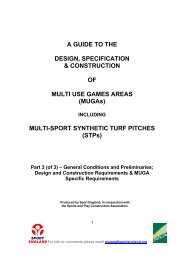View - North East Lincolnshire Council
View - North East Lincolnshire Council
View - North East Lincolnshire Council
Create successful ePaper yourself
Turn your PDF publications into a flip-book with our unique Google optimized e-Paper software.
BOC Immingham Dissolved Acetylene Project Environmental Statement: Vol. 2 Main Text<br />
3.38 The lime settles to the bottom of the Generator from which it passes, as a slurry, through a seal<br />
leg, via a crude filter (to remove solid impurities, e.g. coke, present in the carbide), to the Lime<br />
Sump. From the Lime Sump the slurry is pumped to one of three overhead Lime Storage Tanks.<br />
The lime solids in the slurry settle to the bottom of the Tanks and the water is recovered from the<br />
top of the Tanks for reuse in the manufacturing process. Tankers drive under the Lime Storage<br />
Tanks to load the lime slurry product. There is a bund well area below the Lime Storage Tanks,<br />
which is provided as a containment measure in the event of spills an accidental release.<br />
3.39 In the event that there is a period where there are no customers for the lime in slurry form, it can<br />
be fed through a Rotary Drum Filter v to remove excess water and produce a lime paste (with 70-<br />
80% solids content). The extracted water would be recycled back to the manufacturing process.<br />
The lime paste can either be sold or sent for offsite disposal.<br />
3.40 Prior to filling, all cylinders will undergo an external visual examination at the sort dock.<br />
Periodically, typically every five to ten years, cylinders are examined internally in the Cylinder<br />
Examination Shop.<br />
3.41 For empty cylinders that contained acetylene in acetone solvent, as much gas as possible is<br />
recovered via blowdown rigs and returned to the Gas Holder. The cylinders are then devalved,<br />
inspected, re-valved and repainted. Gas that cannot be recovered to the Gas Holder results in the<br />
release of small amounts of residual acetylene gas which is vented to atmosphere. A vent has<br />
been provided on the roof of the Cylinder Examination Shop for the disposal of this gas and<br />
residual acetylene from third party cylinders that do not contain acetone as the solvent.<br />
3.42 Shot blasting facilities and a Paint Shop are provided within the Cylinder Examination Shop. Dust<br />
emissions from shot blasting and painting activities will be minimised through use of appropriate<br />
filters suppression systems. Solvent emissions from painting and drying will be minimised (so far<br />
as possible) through the selection of the application method and the type of paint, and will be<br />
emitted through vents on the roof of the Cylinder Examination Shop.<br />
Rainwater Harvesting<br />
3.43 The rainwater from the Cylinder and Bundle Filling and Generator Building roofs will be collected<br />
and then stored within an above ground Rainwater Harvesting Tank. The Tank is located adjacent<br />
to the south gable of the Generator Building. The rainwater that collects in the tank will pass<br />
through a filter and be pumped to a water softener (see below) before discharging into the<br />
process water ‘Break Tank’. The water from the Break Tank will then be used to serve the process<br />
requirements of the site. Any excess flow will pass to the Site Drainage System (see paragraph<br />
3.52 onwards).<br />
Water Softening<br />
3.44 Water used in the process plant that generates, purifies and compresses acetylene needs to be<br />
softened. A Water Softener package will be installed, located in the south east corner of the<br />
Generator Building. The water softener will be able to treat all sources of water (i.e. the potable,<br />
non-potable supplies and recovered recycled water). Approximately twice a month the water<br />
softener will need to be regenerated, which will produce hard, salty water (i.e. a brine solution<br />
containing calcium ions), which will discharge to Middle Drain.<br />
v It has not been confirmed whether the Rotary Filter will definitely form part of the final design, however, it is included on the current<br />
layout drawings (see Figure 3.3), and is located adjacent to the Lime Storage Tanks.<br />
5100935.404 Environmental Statement August 2011 22




